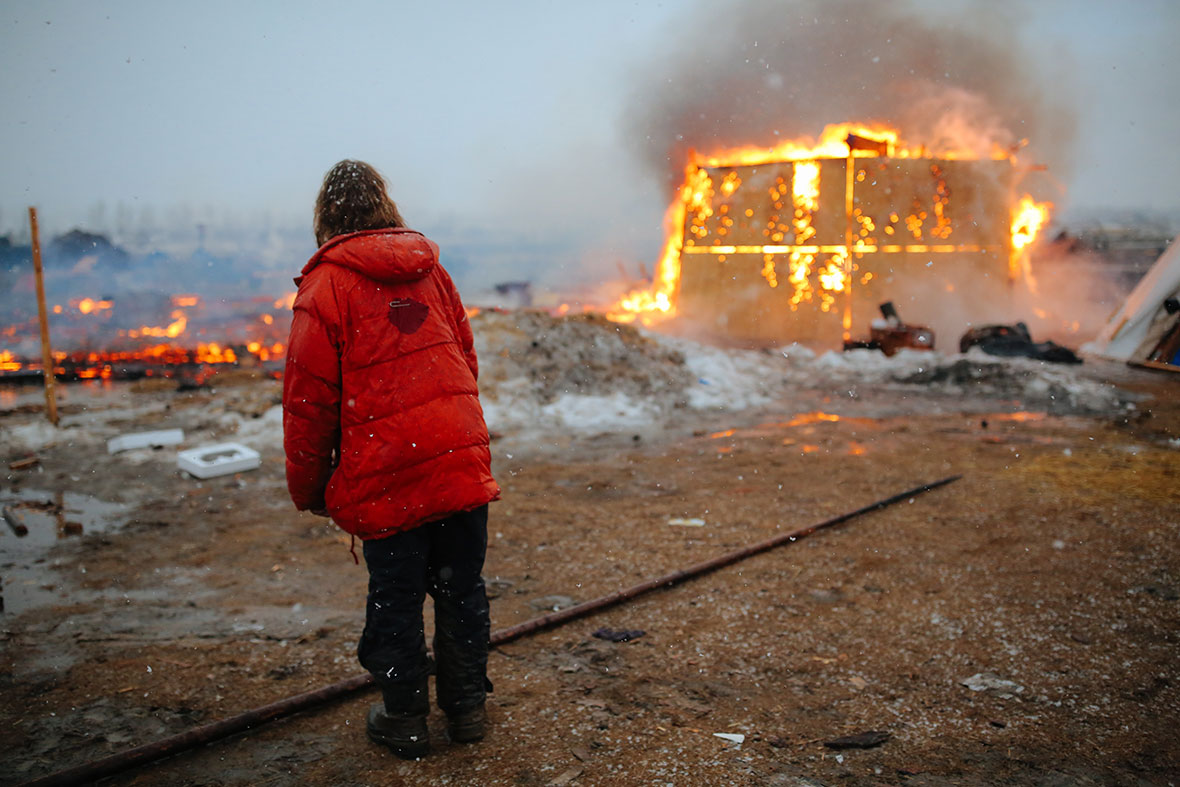Standing Rock goes up in flames as Dakota Pipeline protest camp slowly empties
The area has been home to demonstrators for nearly a year as they tried to prevent the Dakota Access Pipeline from being built.
As freezing rain and snow fell, some of the last remnants of the Oceti Sakowin camp were burned to the ground on Wednesday (22 February) as occupants set fire to makeshift wooden houses and structures, as part of a leaving ceremony ahead of a 2pm deadline to vacate the federal land in Cannon Ball, North Dakota. The area near the Standing Rock Indian Reservation has been home to demonstrators for nearly a year as they tried to prevent the Dakota Access Pipeline from being built.

Shortly before the deadline set by the US Army Corps of Engineers, about 150 people marched arm-in-arm out of the soggy camp, singing and playing drums as they walked along a highway. It was not clear where they were going. One man carried an upside-down American flag. Around three dozen protesters gathered near the camp entrance as the deadline passed. About 20 police vehicles waited further along the road and a few dozen protesters remained in other parts of the camp, a Reuters witness said.





At least nine people were arrested, as a few dozen demonstrators opposed to the pipeline defied the deadline that was given. Most of the campers left the area beforehand, however, public officials in North Dakota pleaded with the remaining protesters at the camp to pack up and leave so authorities could resume cleaning up the premises without any further arrests. North Dakota Governor Doug Burgum said none of the law enforcement officers had left the main highway outside the camp. "They will have every opportunity again to leave tomorrow without arrest," Burgum told the Associated Press on Wednesday evening, referring to an estimated 25 to 50 people who remained at the camp.





Authorities sent buses to take protesters to Bismarck, where they were offered fresh clothing, money for their bus fare home, and food and hotel vouchers. Officials didn't immediately know how many people took up the offer, but said at least 70 people were looking for transportation. Some of the protesters were focused on moving off federal land and away from the flood plain into other camps.
New camps are popping up on private land, including on the Cheyenne River Sioux set up about a mile from the main camp. Nathan Phillips, a member of the Omaha Tribe in Nebraska, told the AP he was moving to a new camp in the area because "there's still work to be done". He has been in North Dakota since Thanksgiving (24 November 2016) and that he has had "four showers since". Matthew Bishop, from Ketchikan, Alaska told the newswire that he had packed up on Wednesday and said he too was headed to a camp on private land. "We're going to regroup and see what we can do," Bishop said.




The Standing Rock Sioux asked protesters to leave the area in December as they challenged the pipeline plans in court, but some 300 demonstrators had remained. At the height of the protests, Oceti Sakowin hosted thousands of people, though its population dwindled to just a couple of hundred as the pipeline battle moved into the courts.
Since taking office last month US President Donald Trump has pushed for completion of the multimillion dollar project, despite objections from Native Americans and environmental activists who say it threatens the water resources and sacred land of the Standing Rock Sioux Tribe. Trump signed an executive order clearing the way for the $3.8bn (£3.04bn) pipeline to proceed on 24 January.



Visit the IBTimes UK Pictures page to see our latest picture galleries.
© Copyright IBTimes 2024. All rights reserved.






